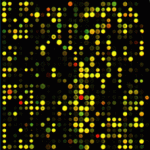Genomics
|
5 september 2015 03:34:19 |
| Genomic profiling of fungal cell wall-interfering compounds: identification of a common gene signature (BMC Genomics) |
|
Tweet Background:
The fungal cell wall forms a compact network whose integrity is essential for cell morphology and viability. Thus, fungal cells have evolved mechanisms to elicit adequate adaptive responses when cell wall integrity (CWI) is compromised. Functional genomic approaches provide a unique opportunity to globally characterize these adaptive mechanisms. To provide a global perspective on these CWI regulatory mechanisms, we developed chemical-genomic profiling of haploid mutant budding yeast cells to systematically identify in parallel those genes required to cope with stresses interfering the cell wall by different modes of action: β-1,3 glucanase and chitinase activities (zymolyase), inhibition of β-1,3 glucan synthase (caspofungin) and binding to chitin (Congo red).
Results:
Measurement of the relative fitness of the whole collection of 4786 haploid budding yeast knock-out mutants identified 222 mutants hypersensitive to caspofungin, 154 mutants hypersensitive to zymolyase, and 446 mutants hypersensitive to Congo red. Functional profiling uncovered both common and specific requirements to cope with different cell wall damages. We identified a cluster of 43 genes highly important for the integrity of the cell wall as the common “signature of cell wall maintenance (CWM)”. This cluster was enriched in genes related to vesicular trafficking and transport, cell wall remodeling and morphogenesis, transcription and chromatin remodeling, signal transduction and RNA metabolism. Although the CWI pathway is the main MAPK pathway regulating cell wall integrity, the collaboration with other signal transduction pathways like the HOG pathway and the invasive growth pathway is also required to cope with the cell wall damage depending on the nature of the stress. Finally, 25 mutant strains showed enhanced caspofungin resistance, including 13 that had not been previously identified. Only three of them, wsc1Δ, elo2Δ and elo3Δ, showed a significant decrease in β-1,3-glucan synthase activity.
Conclusions:
This work provides a global perspective about the mechanisms involved in cell wall stress adaptive responses and the cellular functions required for cell wall integrity. The results may be useful to uncover new potential antifungal targets and develop efficient antifungal strategies by combination of two drugs, one targeting the cell wall and the other interfering with the adaptive mechanisms. |
| 146 viewsCategory: Genomics |
 Lasting effects of early exposure to temperature on the gonadal transcriptome at the time of sex differentiation in the European sea bass, a fish with mixed genetic and environmental sex determination (BMC Genomics) Lasting effects of early exposure to temperature on the gonadal transcriptome at the time of sex differentiation in the European sea bass, a fish with mixed genetic and environmental sex determination (BMC Genomics)The primary reasons behind data sharing, its wider benefits and how to cope with the realities of commercial data (BMC Genomics) 
|
| blog comments powered by Disqus |
MyJournals.org
The latest issues of all your favorite science journals on one page
The latest issues of all your favorite science journals on one page



